The standard – Oxford English Dictionary – definition of risk is:
Noun: A situation involving exposure to danger.
Verb: To expose (someone or something valued) to danger, harm, or loss.
It is easy to see how both the Financial Industry Regulatory Authority (FINRA) and the Securities and Exchange Commission (SEC) transferred this base definition of risk onto the ‘risk’ of an investment. In this reading, the ‘risk’ of a stock, bond, mutual fund, or ETF (the danger that an investor is exposed to) is the loss of value of the investment.
It is equally easy to see how both the public and the financial press have come to believe that ‘risk’ in their investments is a reference to the potential for loss of all or a portion of the value of those investments.
There are all kinds of sub-categories of risk (different types of risk) that lead to losing value. But, the “risk” for all of these parties of investment XYZ is that it loses value.
Based on the accepted definition of ‘risk’ above, the thing it appears we are trying to protect is the number of currency units owned. If I take $1000 and place it in a stock that can decline in value 50% in a 2-year time frame, well, that is risky (even if it could advance that same amount or more). If, however, I take the same $1000 and place it in a bond that promises to pay me 1.5% interest and return my principal at the end of the same 2-year period, then that appears safe.
Two canonical beliefs of investing find their foundations in this definition of risk:
- Fixed-income/Bonds are considered ‘safe’ because of their relative steadiness, the consistent payment of their dividends/interest, and the regular return of principal to their investors.
- Stocks/equities/shares in the great business of US and the world are deemed ‘risky’ because they have a propensity to decline in value more often and by a larger amount.
This all makes intuitive sense. Given the extreme volatility of our financial world and the mother of all cognitive biases (Loss Aversion or Prospect Theory), this IS largely how the investing public, the financial punditry, and the regulators define the concept of risk.
Before we move to the next section, ask yourself… “Do I believe that the real risk of investing is the loss of investment value?”
But… Give it Time!
The problem with accepting this very standard definition of “Risk” is that it is literally devoid of a critical aspect of personal finance – TIME!
When we add time to the analysis of risk, a different risk definition is born. Think of the next 30 years of your own life. What do you want your money to be able to do?
For me, I have two kids – one 14 and one 17. My oldest, Eli, may or may not go to college right away – it all depends on his music career. His mom and I really want him to go to college – not because we think it is important that he study engineering or science… but because it will teach him both how to think and help him evaluate the relative importance of the topics that confront him.
My youngest, Annie, on the other hand has been talking about being a pediatrician for as long as I can remember. That is a lot of years of college. When she was 4 or 5 years old, she had a little medical kit and we would pretend that I had an appointment and she was my doctor. She would listen to my heart and take my blood pressure and usually give me a Band-Aid or, more likely, apply a whole box of Band-Aids to an imagined hurt. As she has grown, she has never seriously wavered from this path.
At the same time, my wife and I have always wanted a home in the mountains (we are currently thinking Kirkwood – hat-tip Rachel and Greg). I would like to retire young enough to spend some serious time travelling before we are too old to enjoy it. My two nephews will likely need help given my brother’s death last year. My parents are getting older. I think they will be fine, but I want to be prepared. And, if I can do it, I would really like to support a few organizations (BFHP, Berkeley Community Scholars, ESO Ventures, Berkeley Rotary) with large bequests after my wife and I are gone.
That is a lot of stuff, but I prioritize it this way:
- Kid’s educations
- Retirement income we can’t outlive
- Nephew’s educations
- Parents’ needs (if necessary)
- Travel and/or mountain home
- Legacy – for family and community
‘Risk’ would be defined in this scenario as my inability to accomplish any of the items on my list of plans. Not being able to leave a legacy for my kids or travel extensively or not being able to afford a home in the mountains are the lowest risk items on this list. Not being able to afford retirement or my kid’s educations are the highest risks I face.
An academic would call this uncertainty about lifetime consumption.
This has less to do with immediate past performance or current portfolio value than it does with amount saved; average lifetime returns; and good planning.
How you define “Risk” will determine how you build your portfolio. If you focus on the first definition, then you will automatically favor low volatility – low return investments. This is largely our default setting. Before we think more deeply about the definition of risk, this is where we all start.
If you consider the second definition, then you have more planning to do and trade-offs to make. You have to consider how much your future spending can come purely from your savings. To the extent you can’t save enough, you have to weigh saving more (spending less) vs. enduring greater volatility to achieve a higher lifetime average return.
Next week, I want to show you two reasons time is an important factor in your planning and therefore your portfolio design.





